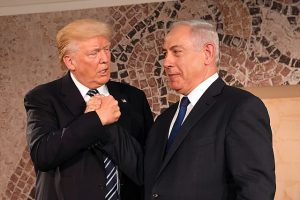by Jim Lobe
First, it wanted the Senate to pass a binding bill (Kirk-Menendez, or S. 1881) that was certain to sabotage the nuclear negotiations between Iran and the P5+1 (the U.S., Britain, France, China, and Russia plus Germany). When that stalled in mid-January at only 59 co-sponsors, all but 16 of whom were Republicans, it initiated discussions about a non-binding resolution essentially endorsing Kirk-Menendez and laying out the conditions for a final “acceptable” agreement with Iran that was also certain to be rejected by Tehran.
It seems now that AIPAC, whose annual policy conference got underway Sunday and is scheduled to last through Tuesday despite ominous warnings of a new winter storm that may limit its 14,000 attendees’ lobbying capabilities, has been reduced to rounding up senators willing to sign a letter to Obama that softens or eliminates some of its previous language but suggests that some of its key demands — most notably, the abandonment by Iran of all uranium enrichment — may still be a sine qua non for Congressional acquiescence to lifting sanctions if and when a final agreement is reached. Gaining as many signatures on that letter as possible is now the top priority in AIPAC’s legislative agenda (although it will also continue pressing lawmakers to co-sponsor or otherwise support S. 1881).
The proposed letter is currently signed by six senators divided in equal parts between Republicans and Democrats. On the Republican side are Lindsey Graham, who’s been wanting to attack Iran for a really long time now; Mark Kirk; and Kelly Ayotte. On the Democratic side are Robert Menendez, Charles Schumer, and Christopher Coons. Of course, Kirk, Menendez, and Schumer were the three out-front and public co-sponsors of what became know as the Kirk-Menendez bill, while the three other letter signers also became co-sponsors. And, of course, Graham’s co-sponsorship, coupled with his long history of war-mongering, makes it difficult for the letter’s Democrats to indignantly insist, as they have in the past, that the letter is designed to reduce — rather than increase — the chances of war. (H/T to Ali)
One has to believe that if AIPAC could’ve gotten one of the Democrats who didn’t co-sponsor S. 1881, they would have preferred him or her to be among the original signatories of the letter. Their absence suggests that the group could run into similar resistance among Democrats even with a much toned-down letter. Indeed, a failure to get more than 59 senators to sign on to a mere letter — which, as I understand it, the administration still strongly opposes due to the baleful impact it could have on the P5+1 negotiations (both on Rouhani’s position and in light of the rapidly rising tensions with Russia over Ukraine ) — would constitute another very serious and highly embarrassing setback for AIPAC amid reports that some of its dissatisfied far-right backers are now mulling the possibility of creating a new lobby group.
But the letter appears to be part of a strategy to overcome that 59-senator threshold. By first asking recalcitrant Democrats to co-sponsor Kirk-Menendez, AIPAC knows it will likely be turned down, at least at this point. But then, by making a second “ask” — to sign a more innocuous-sounding letter — it no doubt believes that a number of Democrats who are uncomfortable about rebuffing AIPAC and/or not sounding “tough” on Iran and/or vesting complete confidence in Obama’s diplomacy strategy at a moment when it is under attack from the right over Ukraine, Syria, etc. etc., will go along in hopes that the Israel lobby will give them a gold star for campaign contribution purposes and not darken their doorway for at least a few months. It seems like a sound strategy, and, if successful, it would help demonstrate to AIPAC’s donors that its effectiveness has not diminished too much, in spite of its recent defeats.
Several points about the letter deserve highlighting:
First, AIPAC has dropped the “wag the dog” provision that called on Washington to provide all necessary help, including military support, to Israel in the event that its leaders felt compelled to attack Iran’s nuclear program. It also forgoes explicit military threats. And, of course, it is non-binding.
Second, it is ambiguous at best about whether its signers find acceptable any final agreement that permits Iran to engage in any uranium enrichment. Its ruling out any recognition of a “right to enrichment”; its demand that such an agreement preclude any “uranium pathway to a bomb;” and its insistence that any agreement cannot lead to any enrichment elsewhere in the region suggest that its authors have not given up on Israel’s “zero-enrichment” position, a stance that the administration and Tehran and Washington’s P5+1 partners all believe is completely unrealistic.
On the other hand, the assertion that there is “no reason for Iran to have an enrichment facility like Fordow” is more intriguing, depending on how you interpret its meaning. It may mean that the enrichment facility at Natanz is kosher, in which case it accepts future Iranian enrichment and demands only that an underground facility like Fordow, which is far more difficult to attack, be dismantled. Or it may mean that it objects to Fordow simply because it is an enrichment facility, thus making Natanz equally objectionable. Indeed, the ambiguity may be deliberate on AIPAC’s part, designed to appeal to those senators who choose to believe that the letter gives the administration the flexibility to accept a limited enrichment program, when, in fact, the letter’s intention is to reduce or eliminate that flexibility.
Third, the letter’s demand that any final agreement “must dismantle Iran’s nuclear weapons program” is tendentious and provocative, not to mention factually inaccurate, simply because neither U.S. nor Israeli intelligence believes that Tehran has made a decision to build a weapon. What we know — and the Iranian authorities admit — is that it has a nuclear program with elements that could contribute to building a bomb, IF and only IF a decision is made to do so. So how do you dismantle a nuclear weapons program if your intelligence agencies believe there is no such thing?
You may see other problems with the language, the ambiguities of which, as noted above, may be intended to rope senators back into the AIPAC fold and get them to sign on to a letter that could be used against them in the future if they try to stick to the administration’s determination to exhaust diplomatic options. Much will now depend on the attitude taken by both the administration and the ten Democratic Senate chairs who came out early and strongly against a vote on Kirk-Menendez.
Here’s a copy of the letter that is being circulated:
[gview file=”http://www.aipac.org/~/media/Publications/Policy%20and%20Politics/Source%20Materials/Congressional%20Action/2014/SenateIranLetter.pdf”]






This currant plan “C” has been expected, especially since plan “A” & “B” didn’t, and BIbi is coming to town. Could this foreshadow the “tough talk” that he’ll-Bibi-give to the congregation? I guess we just have to wait until the “fat lady sings” to find out.
AIPAC has had to tone down it’s warmongering, but is still a great threat to peace in the world. It will always represent Israel in Congress, and Israel’s insistence on being the only nuclear weapons nation in the region. It also does not want the US to reconcile with Iran. This fact is always ignored in the mainstream media. Protecting Israel’s image is still seen as a vital part of the mainstream media’s job. This is our America, warmongering and protector of apartheid Israel.
The P5+1 have indicated to Iran that Iran will be allowed to enrich uranium to low levels. Is this not acceptable to some of the Aipac stooges in the US Congress?